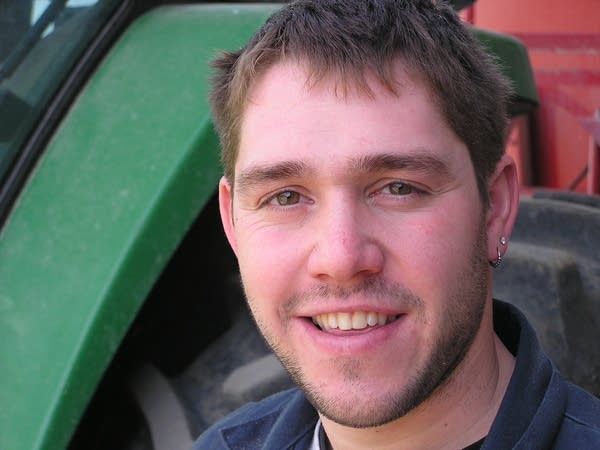Farm installs robotic milkers


In a new barn at the Goblirsch dairy a cow stands quietly as it gives up it's most recent production to the milking machine. The milk pulses rhythmically through pipes on it's way to a holding tank.
It's basically the same sound farmers have heard for years as they stooped to hook and unhook cows to the milking unit.
What's different here happens when the job is finished. A computer tells the robot to detach the milking cups from the cow. Then with a series of clicks and pops, the robot arm swings the milking unit out from under the animal.
Matt Goblirsch takes it all in. He says he's gone through a variety of emotions since the robot milkers were installed a few weeks ago.
Create a More Connected Minnesota
MPR News is your trusted resource for the news you need. With your support, MPR News brings accessible, courageous journalism and authentic conversation to everyone - free of paywalls and barriers. Your gift makes a difference.
"The cows will pretty much just milk themselves."
" (I'm) a little bit nervous, but it's pretty neat," says Goblirsch. "I'm pretty proud of this since we got it going."
As one cow leaves the milking stall there's another animal at the other end waiting to enter. The computer swings a gate open as soon as there's a vacancy.
When the new cow comes in it heads for a special feeding station at the end of the stall. While the cow eats, a computer reads the animal's ear tag. Using stored information about the cow's height, the robot arm swings the milking unit into position, then attaches the cups.
"When it's up and running, the cows will pretty much just milk themselves," says Goblirsch. "Whenever she feels like she wants to be milked, she'll come in this robot, she'll get a little treat and then she'll exit the robot."

Right now it's still training time. Some cows enter the stall by themselves. Others have to be nudged in.
Goblirsch, his brother and their parents watch the process. Their decision to install robots is as much a lifestyle decision as economic. Cows must be milked two or even three times a day, every day. Matt Goblirsch says the robots will do that job unattended.
"We just discussed it. We sat down with the family, we were, like, you know, "What do we really want to do?" says Goblirsch. "Well, we really don't want to live in a barn, but we still think that that's the only way we can make the money. So we decided let's go with robots where we can milk fewer cows, but yet milk them more times a day and us not having to be there."
He hopes the robots mean eight hour work days can replace the all-too-often 14 hour shifts he's worked in the past. Fewer hours in the barn also means more time to tend crops and other tasks around the place.
Those sorts of considerations are something many Minnesota dairy families are talking over these days. The state's dairy industry has been in serious decline for at least 20 years. Thousands of farms have gone out of business.
There was a glimmer of good news last year. For the first time in four years, the state's milk production actually went up. Dairy families face a multitude of decisions: should they expand, go organic, get out?
University of Minnesota professor Marcia Endres says often the choice is decided by the personality of the individual running the operation.
"You need to fit the system with the manager, I think," says Endres.
Endres says robotic milkers work best in computer savvy operations. Score one here for the Goblirsch's. Matt says he and his brother love technology. Good people managers may choose another route. They may go heavy on labor, expanding the herd and then hiring workers to run the place. Endres says each system has its trouble spots.
"Things happen with the robots and you need to be on-call and get those fixed right away," says Endres. "And also some more major problems could be of a concern if you don't have a service representative nearby or someone who can come fairly quickly to solve major issues that could happen. Because it's a piece of equipment and things could happen with it."
Robots are used heavily in Europe, not so much in the U.S. Endres says that's mainly because of different labor costs. Higher costs in Europe means it may be cheaper to buy machines to do the work.
Matt Goblirsch says there's been a lot of interest in the family's robot milkers. For now he wants everyone to stay away until the cows get used to the system. He says if they work out, the family may buy more robots in the future and expand the herd.
